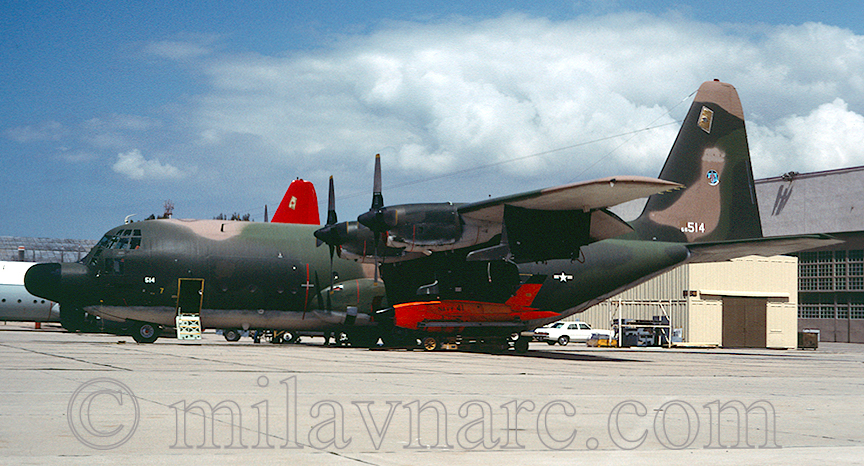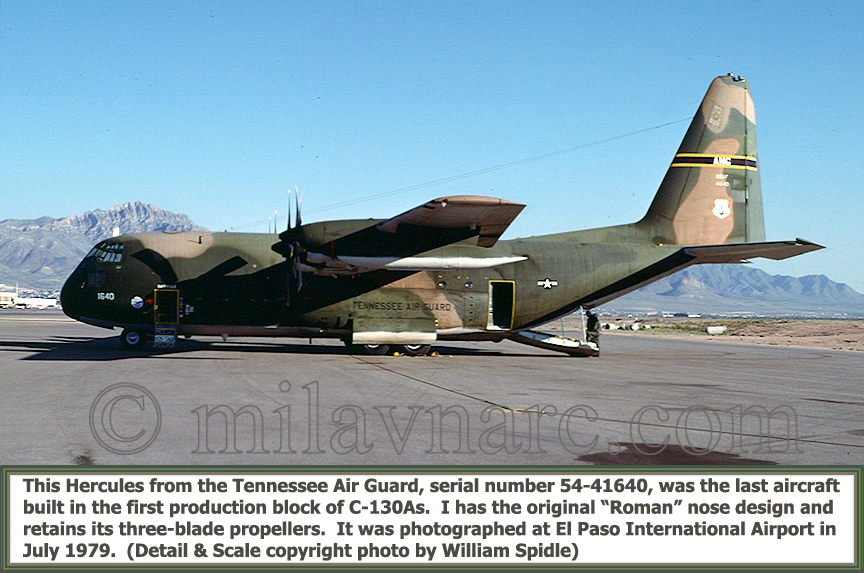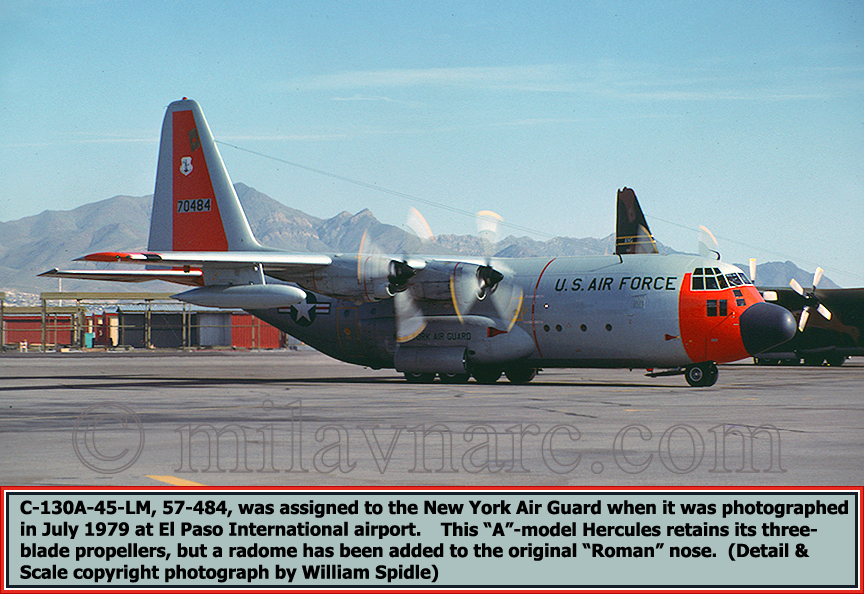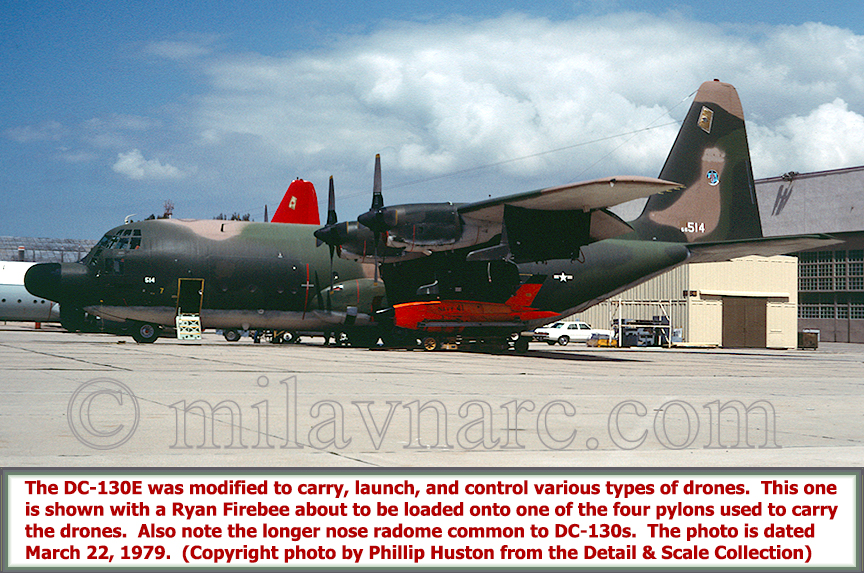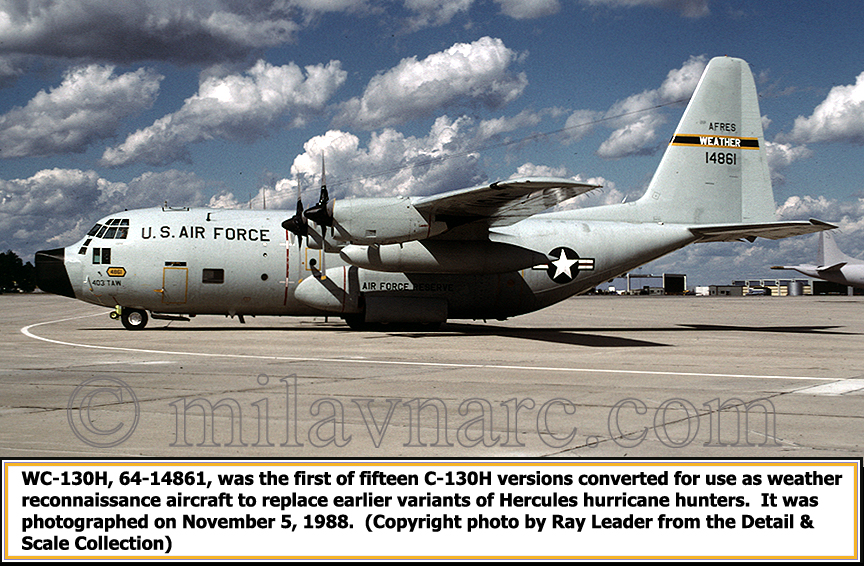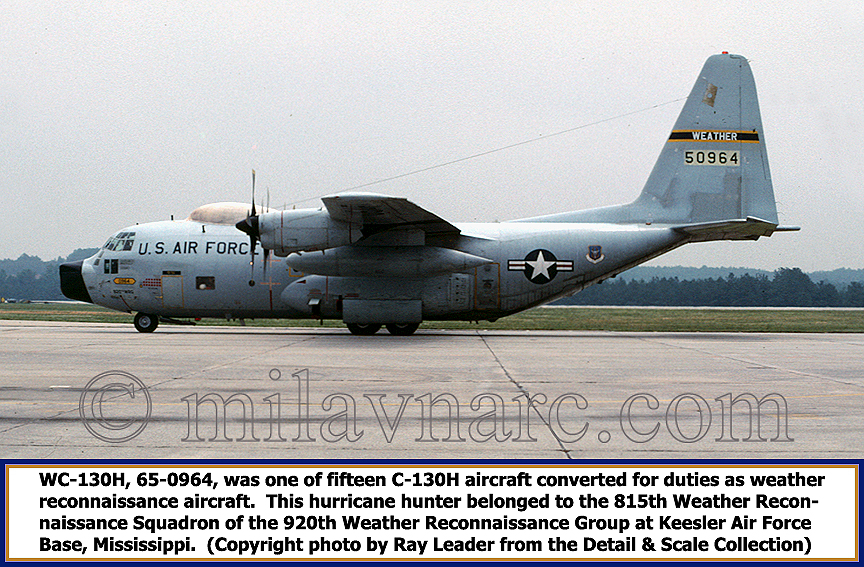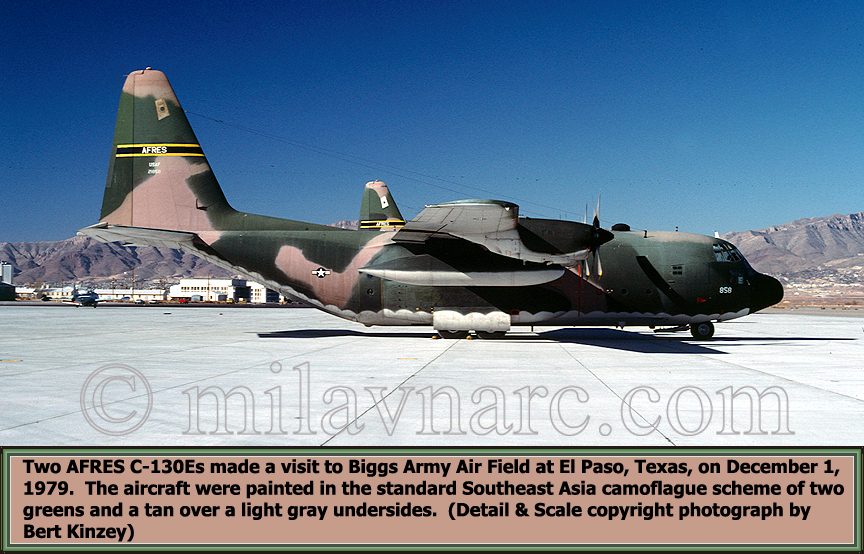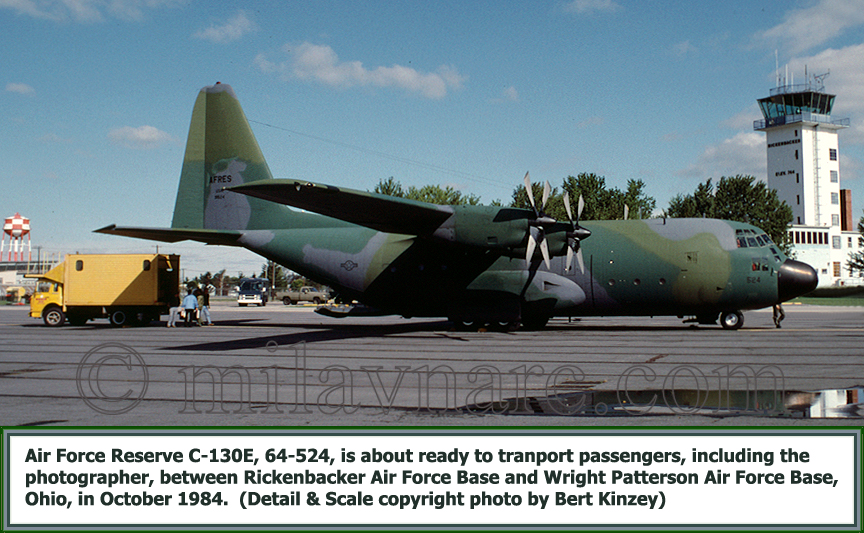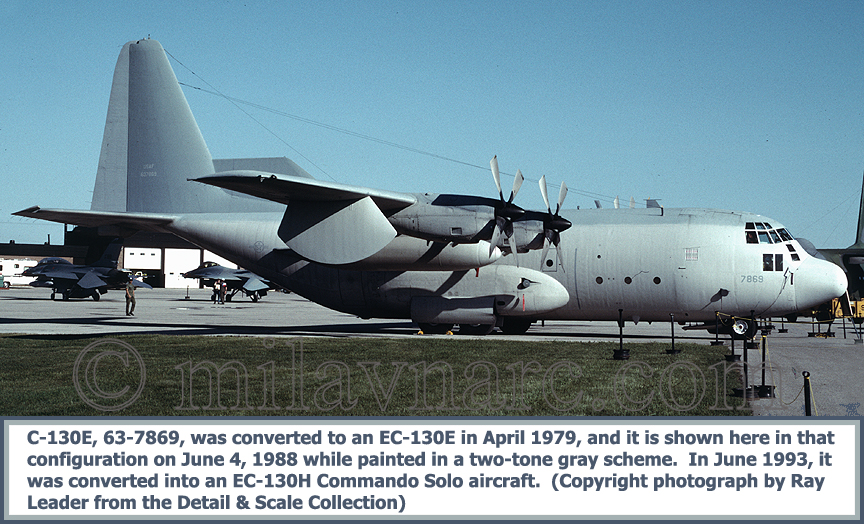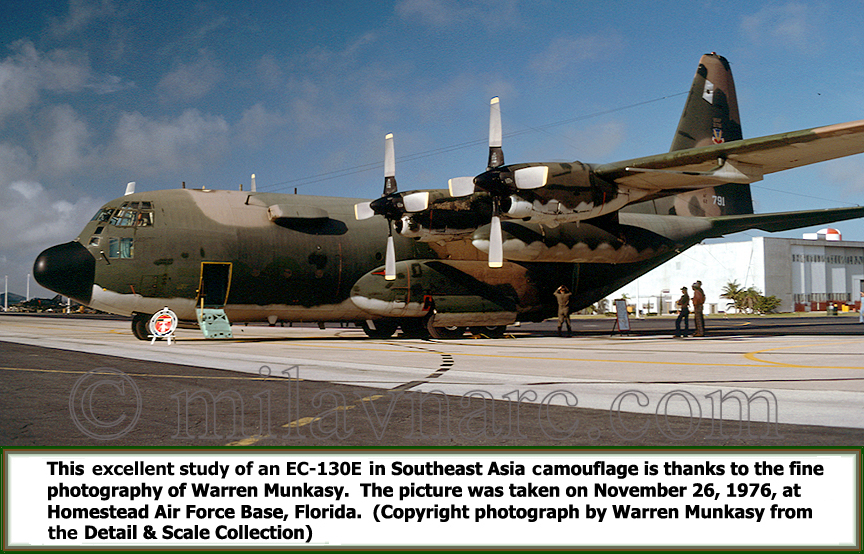USAF C-130 Hercules Information File:
The Lockheed C-130 is one of the most significant aircraft in the history of military aviation. It has now been in continuous production longer than any other military aircraft in history, and it has been in service for more than fifty years. Although originally designed as a tactical airlift transport, it has been used for a wide variety of other missions as well. C-130s have been built or converted to gunships, drone controllers, hurricane hunters, electronic warfare platforms of various types, special operations aircraft, tankers, reconnaissance aircraft, Arctic and Antarctic support aircraft, command and control aircraft, fire fighters, and rescue aircraft. C-130s have also been flown by almost seventy foreign nations in addition to the United States Air Force, Navy, Marines, and Coast Guard. More than forty different variants have served with various air forces since the Hercules was first introduced. Some have also been purchased and used as transports by civilian corporations under the L-100 designation.
Design work on the Hercules began during the Korean War when a need for a better and more versatile tactical airlift transport was identified. The first flight took place on August 23, 1954, and the first production C-130A began service with the U. S. Air Force in December 1957. The tactical airlift Hercules was designed to be capable of operating from unimproved airfields, and it could also utilize air drop and low-level extraction deliveries to provide equipment to forces operating in the field.
Powered by four Allison T56 turboprop engines, the Hercules could take off and land in a relatively short distance. When a quick take off was needed at high weights, jet-assisted take-off (JATO) bottles could be added to the sides of the fuselage. The turboprop engines provided greater efficiency and range than comparable piston engines and delivered more horsepower for the same amount of weight.
The first variant to go into production was the C-130A which was powered by four Allison T56-9 turboprops turning three-blade propellers. These were followed into production by the C-130B, which had several improvements. Significant among these was the increase in fuel capacity and the resulting additional range. C-130Bs also were fitted with four-blade propellers, and these were also retrofitted to some C-130As.
The next major production version was the C-130E, which had extended range through the installation of larger external fuel tanks under the wings. Unlike the earlier variants, these larger tanks were carried on pylons between the numbers one and two engines under the left wing and numbers three and four engines under the right wing. On the earlier versions, the smaller external tanks had been carried outboard of the numbers one and four engines. The C-130E was powered by more powerful Allison T56-A-7A turboprops.
The first KC-130F tankers were ordered by the Marines in 1958, and these utilized the probe and drogue system favored by the Navy. A 3,600-gallon fuel tank was carried inside the fuselage, and this fed fuel out to two refueling pods mounted under the outboard wing panels. These tankers were capable of refueling two aircraft at one time. Later, KC-130Gs replaced the earlier KC-130Fs, and still later KC-130R and KC-130T versions were introduced. The U. S. Air Force also ordered KC-130 tankers for use in special operations where they are more suited for the requirements than the KC-135 and KC-10 jet tanker aircraft.
Another early variant of the Hercules was the DC-130A drone control aircraft. Used by both the Air Force and the Navy, these aircraft could carry and direct up to four drones of various types. The DC-130As were fitted with a larger chin radome with a control antenna. They were assigned to the 11th Target Drone Squadron and the 350th Strategic Reconnaissance Squadron.
While the DC-130As with the 11th Target Drone Squadron were used for training purposes, those with the 350th Strategic Reconnaissance Squadron were used in combat. This squadron flew DC-130As, and later DC-130Es, out of U Tapo Air Base, Thailand. Carrying Ryan AQM-34 RPV reconnaissance drones, these drone controllers would stand off in a safe area and launch their drones to fly over well defended targets in North Vietnam and along supply routes to gather intelligence. While many drones were shot down, they provided the necessary intelligence without risking American lives in the process.
Two of the U. S. Air Force’s eight DC-130As were transferred to the Navy and assigned to VC-3. These were later replaced by two DC-130Es which were transferred from the seven DC-130Es used by the Air Force.
Major improvements were introduced with the C-130H which had Allison T56-A-15 turboprops and other upgrades. “H” models entered service in 1964, and they remained in production for thirty-two years. Many are still in use well into the twenty-first century. C-130K and C-130T variants have also been added to the basic tactical airlift versions of the Hercules that have been produced, and the C-130J Super Hercules has entered production.
In the Vietnam War, special operations became an important part of aerial and ground warfare. Very specific and demanding requirements spawned several special operations versions of the Hercules. Among these were the MC-130E Combat Talon. Some, but not all, MC-130s were fitted with the Fulton Recovery System which can be used to extract special operations forces from remote areas. In the 1990s, MC-130Es started to be replaced with MC-130H Combat Talon II aircraft, and later the MC-130W Combat Spear and Dragon Spear variants entered service. MC-130P Combat Shadow tankers were another special operations variant of the Hercules used by the Air Force, and these are now scheduled to be supplemented by, and eventually replaced with, the new MC-130J Combat Shadow II version.
Starting in World War II, major air forces began to realize the importance of electronic warfare in the air, and both offensive and defensive systems were developed, as was electronic intelligence equipment. Other missions in electronic warfare included psychological operations, battlefield command and control, and airborne early warning. The Hercules proved to be an excellent aircraft for many roles in the electronic warfare arena. EC-130E Commando Solo aircraft were a psychological operations variant, as was the EC-130E Rivet Rider. Another EC-130E sub-variant was used as a battlefield command and control aircraft, so the EC-130E designation was used for more than one sub-variant of the electronic warfare versions of the Hercules. EC-130H Compass Call aircraft were involved in active electronic warfare, while the EC-130V was an airborne early warning and control aircraft used by the U. S. Coast Guard for counter drug-running missions.
The Navy used its EC-130s in the TACAMO role to provide secure communications with ballistic missile submarines that were out of range of normal Navy communications link. In 1963 a KC-130F was used to develop the concept called TACAMO I by the Naval Air Test Center. Four EC-130Gs served as TACAMO II aircraft in this role, and beginning in 1969, the EC-130Q became the TACAMO III.
The gunship versions of the Hercules started being used in Vietnam, beginning with the AC-130A. AC-130Es followed, and then came the AC-130H. Most AC-130Es were subsequently upgraded to AC-130H standards. These gunships have proven to be an effective system in combat since Vietnam, and they have demonstrated their worth in the War on Terror serving in Iraq and Afghanistan. They have shown their ability to deliver effective fire on the enemy in situations where other systems are not nearly as effective. The AC-130H carries weapons including 7.62-mm mini-guns, 20-mm Vulcan cannon, a 40-mm Bofors cannon, and a 105-mm howitzer. A more recent gunship version is the AC-130U, and the AC-130J is in production, because the need for effective gunships remains high.
The U. S. Coast Guard and the U. S. Air Force both use HC-130s for rescue missions. Early rescue versions included the HC-130B, HC-130E, and HC-130H. More recently, the Air Force added the HC-130P and HC-130N Combat King variants which can serve as an aerial refueling tanker and combat search and rescue aircraft. These well-equipped aircraft can deploy rescue personnel and equipment by parachute, and they can serve as tankers to refuel rescue helicopters during a mission. For fifty years, the several sub-variants of the HC-130 have served as rescue aircraft in both combat and civilian situations. This mission will continue with the new HC-130J Combat King II.
LC-130F, H, and R versions were equipped with skis for operations in the Arctic and Antarctic. Ski-equipped Hercules have served with both Navy and Air Force units.
Another important role played by the Hercules was as a weather surveillance aircraft, more commonly known as a hurricane hunter. WC-130A, B, E, and H weather reconnaissance aircraft have been produced and flown in support of the National Hurricane Center. A new WC-130J will be added to the list of hurricane hunting aircraft in the Hercules series.
Although the new C-130J Super Hercules with its turbofan engines has entered production, many earlier models of the Hercules will remain in service around the globe for decades to come as they perform a wide variety of import missions in support of military and civilian requirements.
C-130H Data
| Wingspan |
132 feet, 7 inches |
| Length |
97 feet, 9 inches |
| Height |
38 feet, 3 inches |
| Powerplants |
4 X Allison T56-A-15 turboprop engines, 4,590 shp each |
| Empty Weight |
75,800 pounds |
| Maximum Take-off weight |
155,000 pounds |
| Payload |
45,000 pounds |
| Maximum Speed |
320 knots at 20,000 feet |
| Cruising Speed |
292 knots |
| Range |
2,000 nautical miles |
| Ceiling |
33,000 feet without cargo |
USAF C-130 Hercules General Photo Set:
This photo set contains general photographs of C-130 Hercules aircraft as flown by the U. S. Air Force that are not included in the more subject-specific photo sets for U. S. Air Force C-130s.
For photos of C-130 Hercules aircraft flown by the U. S. Navy, Marines, and Coast Guard, use this link to go to that area of the Post World War II era for U. S. Navy and Marine aircraft.
Click to go to US Navy, Marines, & Coast Guard

